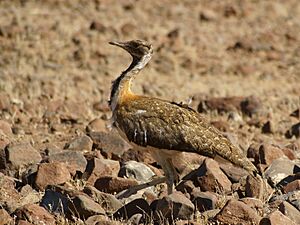Ludwig's bustard facts for kids
Quick facts for kids Ludwig's bustard |
|
|---|---|
 |
|
| Conservation status | |
| Scientific classification | |
| Genus: |
Neotis
|
| Species: |
ludwigii
|
The Ludwig's bustard (Neotis ludwigii) is a type of bird that belongs to the bustard family. It was named after a person called Baron von Ludwig. This bird is known for its medium to large size.
Contents
What Does the Ludwig's Bustard Look Like?
The Ludwig's bustard is a fairly large bird. Males are bigger than females. A male can weigh around 6.3 kilograms (about 14 pounds). Females are smaller, weighing about 3.4 kilograms (about 7.5 pounds).
These birds are also quite tall. Females are usually between 76 to 85 centimeters (about 30 to 33 inches) long. Males are even longer, from 80 to 95 centimeters (about 31 to 37 inches).
Their face and the front of their neck are grey-brown. The back of their neck and head are white. The nape (back of the neck) has a dull orange color. Young birds and females look similar to adult males. However, they are smaller and have slightly lighter colors on their face and front neck.
Sometimes, people confuse the Ludwig's bustard with another bird called the Denham's bustard. But the Denham's bustard has lighter grey on its face and neck. It also has a browner nape and special black and white stripes on its head.
Where Do Ludwig's Bustards Live?
Ludwig's bustards live in savannas and grasslands. They also like semi-arid areas, which are dry but not completely desert. You can mostly find them in the western part of Southern Africa. This includes Western South Africa, Namibia, and sometimes Botswana. Their total living area is very large, about 380,000 square kilometers.
In the 1980s, there were about 56,000 to 81,000 Ludwig's bustards. More recent studies suggest there are now around 114,000 of these birds in South Africa alone.
Scientists used to think these birds moved around to follow rainfall. But new research suggests this might not be true. However, it seems they do like to live in areas changed by humans. This includes farm fields and pastures.
Ludwig's bustards do not gather in huge groups. They are usually seen in small groups. In summer, a group might have about two birds. In winter, groups are a bit larger, with about three or four birds.
How Do Ludwig's Bustards Behave?
Vocalizations
When a male Ludwig's bustard wants to find a mate, it makes a deep "bloop" sound. Scientists do not have a lot more information about the other sounds these birds make.
What Do Ludwig's Bustards Eat?
Ludwig's bustards eat many different things. They can eat small animals found on the ground. This includes insects and small vertebrates (animals with backbones). They especially like to eat locusts, which are common in their habitat. They also eat flowers and seeds.
Reproduction and Life Cycle
It is hard for scientists to study how Ludwig's bustards reproduce. This is because they live in large, remote areas. Also, the birds can get easily disturbed by people trying to observe them.
Because of this, there is not much information about their breeding habits. However, it has been reported that they breed in Namibia during the month of March.
Dangers to Ludwig's Bustards
One of the biggest dangers to Ludwig's bustards is power lines. Many of these birds sadly fly into power lines and die. This happens because bustards have blind spots when they fly. If they look down a little bit while flying, they cannot see obstacles in front of them.
This problem is very serious. It could even put the future of the species at risk. It is estimated that between 4,000 and 11,900 Ludwig's bustards die each year from hitting power lines.
To help protect these birds, scientists need more information and statistics. This will help them create a good plan to save the species. As more power lines and buildings are built in their habitats, the danger to the Ludwig's bustard population will continue to grow.
Images for kids



